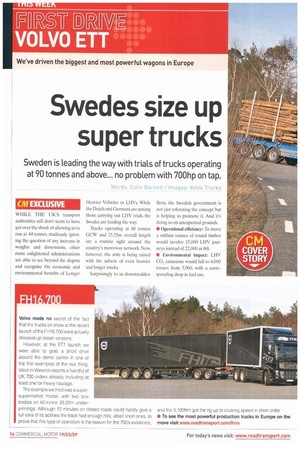Swedes size up super trucks
Page 14

Page 15

If you've noticed an error in this article please click here to report it so we can fix it.
Sweden is leading the way with trials of trucks operating at 90 tonnes and above.., no problem with 700hp on tap.
Words: Colin Barnett / Images: Votvo Truck,.
EXCLUSIVE
WHILE THE UICS transport authorities still don't seem to have got over the shock of allowing us to run at 44-tonnes, studiously ignoring the question of any increase in weights and dimensions, other more enlightened administrations are able to see beyond the dogma and recognise the economic and environmental benefits of Longer Heavier Vehicles or LHVs. While the Dutch and Germans are among those carrying out LHV trials. the Swedes are leading the way.
Trucks operating at 60 tonnes GCW and 25.25m overall length are a routine sight around the country's motorway network. Now, however, the ante is being raised with the advent of even heavier and longer trucks.
Surprisingly to us downtrodden Brits, the Swedish government is not just tolerating the concept but is helping to promote it. And it's doing so on unexpected grounds.
• Operational efficiency: To move a million tonnes of round timber would involve 15,000 LHV journeys instead of 22.000 at 60t.
• Environmental impact: LHV CO, emissions would fall to 4,000 tonnes from 5,900. with a corresponding drop in fuel use.
Volvo made no secret of the fact that the trucks on show at the recent launch of the FH16.700 were actually dressed-up lesser versions.
However, at the ETT launch we were able to grab a short drive around the demo centre in one of the first examples of the real thing. Volvo in Warwick reports a handful of UK 700 orders already, including at least one for heavy haulage.
The example we tried was a supersupermarket model, with two box bodies on 60-tonne 25.25m underpinnings. Although 10 minutes on closed roads could hardly give a full idea of its abilities the track had enough hills, albeit short ones, to prove that this type of operation is the reason for the 700's existence, and the 3,100Nm got the rig up to cruising speed in short order.
• To see the most powerful production trucks in Europe on the move visit www.roadtransport.cornilhvs • Road safety: The lower number of journeys is expected to reduce the risk of collisions, while the effects of the extra mass don't increase significantly beyond a certain point. And research hasn't shown any great increase in risk from cars overtaking longer trucks.
Even the greatest optimist wouldn't expect any government to sign off such an idea on a whim, however, and what we are reporting is the first step in a very tightly controlled and monitored trial.
The move to these super-trucks comes from Sweden's hugely important timber industry, where road transport currently accounts for 25% of the cost of timber production. A whole host of specialist interested panics, including Volvo, the Forestry Research Institute of Sweden and the Swedish Road Administration, have formed a partnership to reduce this cost. The result is the ETT project — ETI' stands for the Swedish phrase. -En Trave or "one more pileThe objective is to carry an extra stack of round timber beyond the three currently hauled by 60-tonne rigs. (See CM 29 January for more details) Conventional spec One stack on the ETI' rig is carried by a Volvo F1116 660 6x4 prime mover, with a fairly conventional spec including a standard 12-speed overdrive 1-shift transmission and an eight-bag. air-suspended drive bogie with single-reduction axles. The Globetrotter XL cab is in a four-passenger driver training configuration. The next link element is effectively a five-axled turntable drawbar trailer carrying a second stack with most of its weight over the front two-axle dolly. At its rear is a fifthwheel coupling, with its pivot point just aft of the centre of the three rear axles, which pulls the final two stacks on a three-axle semi-trailer.
Trailers are made by Parator from SSAB Domex 700 highstrength steel; they combine to give an overall length of just under 30m. At the launch Volvo revealed that the GCW is actually 100 tonnes, although the trial will operate at the originally quoted 90 tonnes. Unladen weight is under 27 tonnes, giving a trial payload of 63 tonnes.
The initial single-vehicle trial is in Northern Sweden on a fixed 170km highway route between a consoli dation depot at Overkalix and th mill at Pita. with two more truck due to start on a Western Swedis route in the coming months. Ili Dynafleet telemetry is monitore by the authorities to ensure rout and speed compliance.
We were only able to do a coupl of laps of Volvo's demo centre vac: but the rig was actually easier drive than a 40-tonner we'd drive ea rlier, whose steering tanker trail( cut in like a talk-show host.
By contrast the ETT rig followc faithfully, even through a tight of traffic cones in a mini-slalom. , U-turn revealed that the quotc turning circle of 23rn is on the col scrvative side — to prove its abili. we watched one of Volvo's drive reverse the rig over more than i own length. •
















































































































































